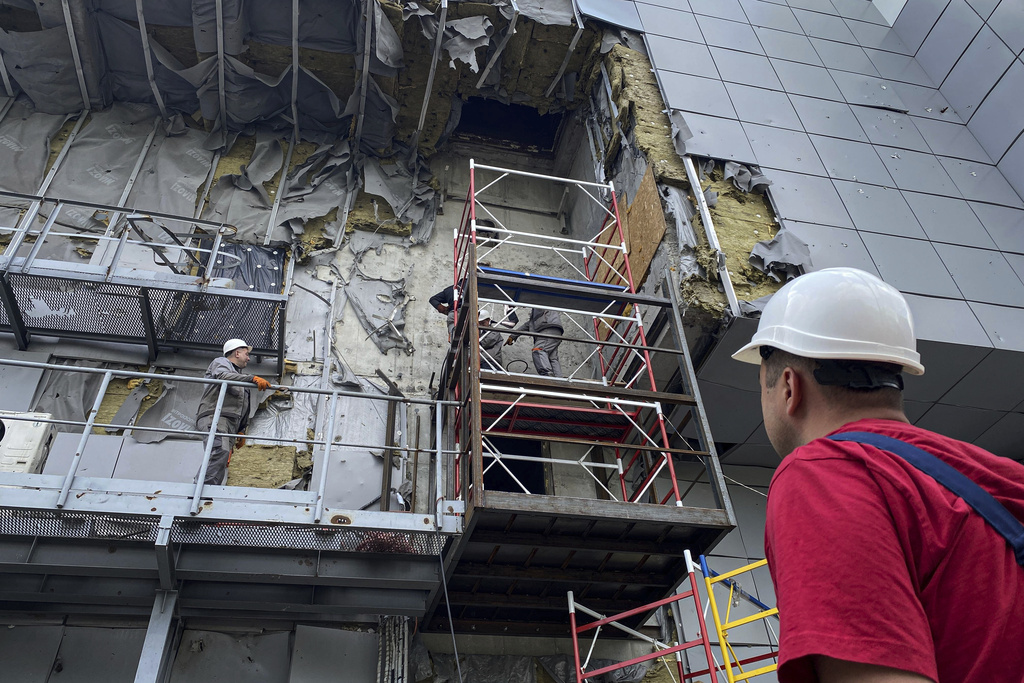There is activity at the Kharkiv Institute of Physics and Technology, but it’s not what scientists at its cutting-edge nuclear laboratory trained for.
Staff at the U.S.-funded atomic research lab in northeastern Ukraine spend their days patching up the facility, which has been badly damaged by repeated Russian strikes.
More than a year after missiles first hit, the wind batters boarded-up windows and exposed insulation flaps. When the Associated Press visited this month, debris had been heaped in piles, and rocket parts sat near craters up to 2.5 meters (8 feet) deep. Staff say the site was struck some 100 times with rockets and bombs during the first months of the war, and attack remains a constant threat. Kharkiv, near the war’s front line and the Russian border, is shelled almost daily from the neighboring Belgorod region of Russia.
Before Russia’s invasion, the institute was a jewel in the crown of Ukraine’s highly developed nuclear research sector. Its experimental reactor had opened only six months earlier, designed to offer training and research facilities and to make medical isotopes used in cancer treatment.
While those fearing a nuclear accident have focused their attention on Ukraine’s huge Zaporizhzhia Nuclear Power Plant, which is under Russian control, the Kharkiv lab’s small reactor also poses a risk, though so far there have been no leaks.
Mykola Shulga, general director of the institute’s National Science Center, said the damage is “significant — but we are doing repairs on our own.”
“The strikes on this installation were intentional,” Shulga said, in front of a modern gray building whose panels have been ripped off or are pocked with shrapnel holes. “This wall here was hit with seven missiles.”
The International Atomic Energy Agency has also accused Russia of “sustained targeting” of the research lab. A delegation from the agency visited in November and found nearly all buildings on the site were damaged, “many of them probably beyond repair.” IAEA chief Rafael Mariano Grossi called the extent of the damage “shocking” and worse than expected.
The one positive note, IAEA inspectors said, was that there had been no release of radiation from the lab’s small experimental reactor.
Ukraine’s nuclear inspectorate said shelling last year damaged the facility’s heating, cooling and ventilation systems. An electrical substation and diesel generators were destroyed, leaving the site without electricity for a time.
The Prosecutor’s Office and the Security Service of Ukraine have opened criminal cases for alleged war crimes and “ecocide” — one of several proceedings accusing Russia of environmental destruction.
“Have a look,” said Galyna Tolstolutska, head of the department of radiation damage and radiation materials science.
“Here, you see. It used to be control panel. Most certainly it’s of no use anymore,” she said, looking around a room of equipment wrecked when the ceiling was shattered by a bomb. “This entire place was exposed to rain, snow, anything.”
In communist times, the Kharkiv facility’s research helped develop nuclear weapons, making it a Soviet equivalent of Los Alamos in the United States. After the collapse of the Soviet Union in the early 1990s, the U.S. agreed to fund Ukrainian nuclear research in exchange for Ukraine getting rid of its stockpiles of nuclear bomb-making material.
The U.S. government says the Kharkiv nuclear facility, built in collaboration with the Argonne National Laboratory near Chicago, is the first of its kind in the world, “designed to produce medical isotopes, train nuclear professionals, support the Ukrainian nuclear industry and provide experimental capabilities for performing reactor physics, materials, and basic science research.” It started operation in August 2021.
Mark Hibbs, a senior fellow in the nuclear policy program of the Carnegie Endowment for International Peace, said the lab was “a unique facility” whose damage in the war is a loss to world science.
“It was on the threshold of being able to be operated as a research tool, and then the war came,” he said.
Russia’s invasion reawakened Europe’s fear of nuclear war, and nuclear accident. Fighting has erupted intermittently around Zaporizhzhia, Europe’s largest nuclear power plant, sparking fears of a catastrophic radiation leak like the disaster at Chernobyl in northern Ukraine, where a reactor exploded in 1986, sending radiation over a vast area.
Kharkiv does not pose the same level of risk. The Kharkiv reactor was put into a “deep subcritical state” — essentially sent into hibernation — on the first day of the war, and it contains far less nuclear fuel than a power plant anyway. Paddy Regan, professor of nuclear physics at the University of Surrey, said research reactors are typically 100 times smaller than civilian nuclear power reactors.
“These accelerator-driven systems are nothing like civilian nuclear reactors,” Regan said. “They’re futuristic design ideas” aimed at creating “an inherently safe reactor system” without the potential for meltdowns of existing power reactors.
“There’s much more danger from the bombs than from any radiation material,” Regan said.
Still, the State Nuclear Regulatory Inspectorate of Ukraine has warned of potential “severe radiation consequences and contamination of the surrounding territories,” should the reactor be damaged. Institute staff say radiation could spread for 6 miles (10 kilometers), covering an area home to 640,000 people.
Depending on weather conditions, the pollution could also reach Belgorod, across the border in Russia, said the center’s deputy director, Ivan Karnaukhov.
“They can blow it all up, but it will also affect their Belgorod region, the radioactivity,” he said. “It won’t be Chernobyl, but there will be significant pollution.” ___
(AP)











